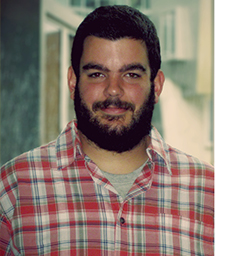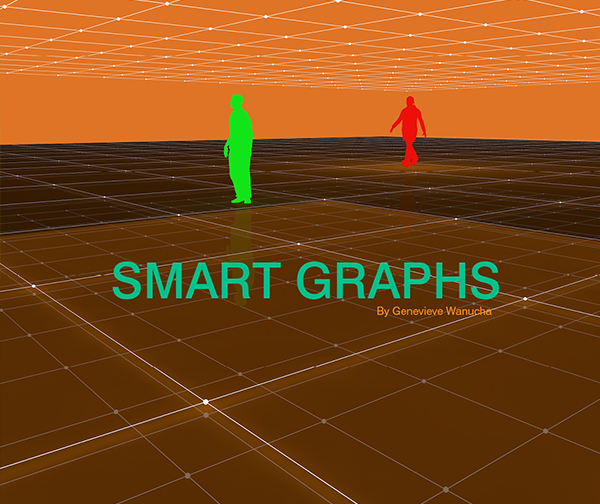Four years ago, when Kimon Drakopoulos was twenty-two, he left Greece to start his master’s degree at LIDS. It was an academic triumph, but just as much a personal one. In Athens, even though students are hardworking, Kimon sensed a widespread attitude that the important thing was to pass exams and get a good job. For Kimon, though, there’s something deeply unsatisfying about the idea of just getting through life – he wanted to do something more. LIDS, and its energetic and collaborative community, became the solution. “I think that’s a big part of why we are all here,” he says.
Intellectual ethos aside, Kimon works at LIDS for the chance to do something untraditional. He had studied computer vision in college, an active field focused on designing computer programs to replicate the brain’s ability to detect and categorize images and movements. The applications to such things as facial recognition and robotic control is interesting, “but the thing is,” says Kimon, “there have been so many people working on it for so many years that you need at least three years to just learn all the details. It takes a lot to do something significant in the field; or at least it would for people with an average mental capacity like me,” he jokes. “I wanted to work on something that hadn’t been explored so thoroughly yet, and make a bigger impact.”
As a network scientist and second year PhD student, Kimon, along with his group and his faculty advisors, Profs. Asu Ozdaglar and John Tsitsiklis, makes this impact by modeling stochastic, or randomly evolving, processes on graphs. It is a different way of looking at how the world works. Graphs involve nodes connected with edges. Nodes can represent, for example, people, while the edges drawn between them reveal their connections. Using historical data, graphs can approximate things like the way information or disease flows through a social network.
One of the most significant future applications of Kimon’s work is contagious disease management. The question occupying him now has to do with finding the smartest way to make and distribute flu vaccines, which is limited by the high expense of manufacturing enough vaccines. With no idea about where the flu will spread, the best bet from a health policy perspective is to vaccinate everyone. But, Kimon points out, a smarter way to vaccinate would be to only give vaccines to people in the position to infect the most people. “That’s my goal,” he says, “I want to find smart ways on graphs to produce the least amount of vaccine, but contain the epidemic fast.”
Kimon wants to use his graph models to decide whom to vaccinate in a certain group of people, given constrains on the budget for producing vaccines. In deciding which two people should get the vaccine, the important information is their neighbors. Kimon likes to use the example of choosing between himself and a professor who will give a lecture tomorrow. “The professor would infect 300 people,” says Kimon, “and I would infect three.” Obviously, if the decision had to be made, the professor should get the vaccine. But there’s a twist. Consider the decision to vaccinate Kimon or a woman who happens to be the professor’s wife. Suppose she has even fewer connections than Kimon, and would infect less people. However, one of the people she would infect would be her husband with the potential to infect the entire lecture hall. So, the vaccination decision depends not only on the immediate number of connections a person has, but also on the nature of their relationship to other people in the network. “That’s what we are trying to find out,” says Kimon, “who is central in the graph, in terms of their potential to infect people.”
Kimon is still tweaking the theoretical underpinnings of this graph. It’s not yet ready for real medical data. But when it is, one big challenge will come with understanding how to use these graphs without complete information about who has the flu or the nature of people’s connections. Kimon says that they will have to partly infer the structure of the epidemic and work out from there. Ultimately, this deeper understanding and ability to predict the scope of future infections would revolutionize the government’s readiness for public health emergencies.
Kimon worked as a data intern at LinkedIn during the summer of 2012, getting the chance to analyze loads of real social network data. From that experience, he says, “I am now pretty convinced that some of the current models are relatively realistic.” He hopes to begin working real data into such models by the end of his PhD work.
What’s even more exciting is that this graphing approach can be applied to any phenomena with “contagious” qualities, whether it is a spreading forest fire, disseminating blog post, viral tweet, or decisions within a social network about buying Androids vs. iPhones. An understanding of how these things evolve would be a goldmine to an endless array of policymakers, advertisers, government agencies and social scientists.
Contributing to research that can make the world a healthier and perhaps more predictable place is not the only thing that Kimon loves to do, though. In the spring and summer, he rides his Suzuki V-Strom to work during the week and into Boston on the weekends. Even though motorcycle riding in Cambridge is not the same thrilling challenge as it is in his hometown of Athens, it is safer and more enjoyable. He’s even ridden this on- and off-road vehicle across the entire United States during the summer of 2012.
In the winter, when traveling on his V-Strom is out of the question, Kimon lately discovered the gym as a true passion. He also cooks. In fact, he recently took a class in the techniques of French cuisine, hoping to finally break away from well-worn Greek recipes and try something new. “I’m a housewife during the winter and a motorcycle rider during the summer,” he says, with his usual mix of honesty and wit that charms his colleagues at LIDS.
When Kimon thinks about the people and experiences that have most influenced him at LIDS, one image pops into his mind: a small sign on his advisor’s desk that reads: Simplify. The motto belongs to John Tsitsiklis, a professor of electrical engineering and co-associate director of LIDS. “That defines his style,” says Kimon. “He’s great at finding the simplest and most intuitive way of tackling a problem, and until he does, things look very complicated.”
Kimon has come to value the power of simplicity throughout his field. Out of all the scholarly reading he’s done, he’s particularly impressed by the monumental work of P.D. Seymour, a mathematician now at Princeton University, who worked out major problems in the properties of graphs. For one specific property “there are 30-page-long papers trying to solve this thing,” says Kimon, “and he came up with a proof that was half a page. That’s something I admire.” Kimon keeps a certain phrase in mind: “take it back to the basics and everything will follow-at least hopefully.”




